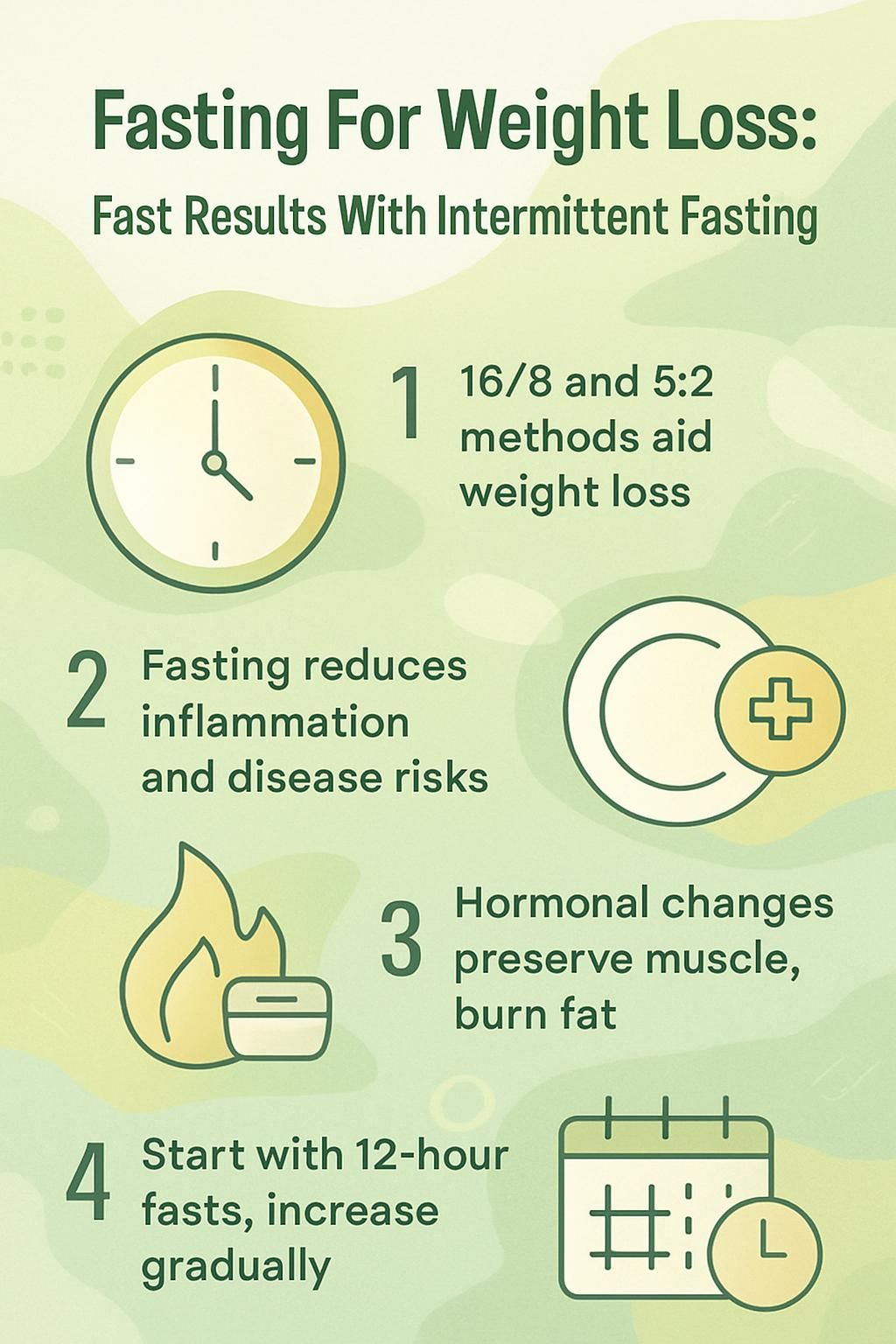Fasting For Weight Loss: Fast Results With Intermittent Fasting
Our Nutrition Assistant AI Suite will transform your body. You will lose fat, get toned, and build muscle. Gain confidence and optimal health.
You have worked hard on strict diets, yet the scale does not move. Intermittent fasting can offer a fresh path for weight loss without counting every bite. This timed eating approach helps you eat within set hours, then fast for the rest of the day.
Research suggests that intermittent fasting may lower body weight, reduce fat, and support heart and metabolic health. In this guide, you will learn how it works, the most popular methods, common hurdles, safety tips, and simple steps to start your own plan.
Keep reading to see how fasting for weight loss could fit your routine.
Key Takeaways
- Time-restricted eating methods like 16/8 and 5:2 can support weight loss and improve insulin sensitivity compared to daily calorie restriction, based on recent reviews and trials (BMJ, June 18, 2025).
- Fasting may lower inflammation markers, such as C-reactive protein, and can reduce risks linked with type 2 diabetes, heart disease, and metabolic syndrome (Mattson et al., NEJM 2019).
- Hormone shifts in insulin, leptin, and growth hormone help you burn more fat while protecting muscle.
- Starting with shorter fasts, such as 12 hours, then extending slowly can ease hunger and improve long-term success (Varady et al., 2015).
- Do not use intermittent fasting if you are under 18, pregnant, breastfeeding, or have a chronic illness without medical guidance.

What Is Intermittent Fasting?

Intermittent fasting is a simple eating schedule. You choose a daily or weekly window for meals, then avoid calories outside that window. This pattern supports weight control and can improve metabolic health, which includes blood sugar, insulin response, and cholesterol.
What does intermittent fasting mean?
You switch between periods of eating and periods of not eating on a set plan. Some plans use daily windows, such as eating for 8 hours, then fasting for 16. Others use weekly patterns, like eating normally five days, then limiting calories on two nonconsecutive days.
During fasting hours, water, black coffee, and unsweetened tea are fine. Any drinks with sugar, cream, or calories break the fast. Many people choose intermittent fasting for weight loss because it reduces overall intake without banning whole food groups.
Fasting has a long history in many cultures. Today, clinical research suggests it is safe for most healthy adults when planned well. Mark Mattson, a research scientist at Johns Hopkins School of Medicine, has studied these patterns for years.
Time-restricted eating shows promise as an effective strategy for weight management,says Dr. Mattson from Johns Hopkins.
Next, see how this approach differs from the daily calorie-cutting diets you may know.
How is intermittent fasting different from traditional dieting?
With intermittent fasting, you focus on when you eat, not only what or how much. You place your meals inside a set window, such as 11 a.m. to 7 p.m., and skip food outside those hours. This can feel simpler than tracking every calorie each day.
Traditional dieting often limits portions or entire food types, which can feel strict. Intermittent fasting lets you enjoy a wide range of nutritious foods during your eating window. Many people find this flexible and easier to keep during busy weeks.
Studies show both approaches can work. Still, time-based schedules often fit daily life better. You avoid late-night snacking, plan fewer meals, and reduce decision fatigue. If you understand the timing, you are ready to learn what happens inside your body.
How Intermittent Fasting Works
Intermittent fasting changes how your body uses energy. It shifts you from constant feeding to planned breaks. These breaks improve how your body handles sugar and fat.
How does calorie restriction aid fat burning?
When you eat fewer calories, the body must tap stored fuel. After a few hours without food, blood sugar drops, then the liver breaks down fat into ketone bodies. This process is called ketosis. It helps your body switch from burning sugar to burning fat.
Short fasting windows, such as 16 hours, can speed this shift. Randomized controlled trials and systematic reviews report meaningful weight loss with intermittent fasting. Many people also find hunger eases after the first week, which makes sticking to a balanced plan easier.
This shift does more than burn fat. It also smooths blood sugar swings and may improve insulin resistance, which is a root problem in type 2 diabetes.
What hormonal changes help with weight loss?
Several hormones move in your favor during fasting. Insulin goes down, so your body can release stored fat. Leptin, the fullness signal, works better. Ghrelin, the hunger hormone, often drops with practice, so cravings fade.
Higher growth hormone during fasting can help protect lean muscle while you lose fat. These shifts support steady weight loss when you pair fasting with protein, fiber, and smart training.
Sources: Mattson MP et al., The New England Journal of Medicine, 2019. Harvie M et al., International Journal of Obesity, 2011.
How does intermittent fasting improve insulin sensitivity and blood sugar?
Fasting gives your body a break from constant glucose. During that break, fasting glucose and fasting insulin often drop. Cells then respond better to insulin during the eating window.
People with prediabetes or type 2 diabetes may see lower insulin resistance with medical supervision. Reviews and meta-analyses show meaningful drops in average fasting glucose within weeks. As your body uses stored glycogen between meals, energy and mood can feel steadier.
Many readers also notice better blood pressure and cholesterol numbers over time. These changes support heart health and long-term weight control.
Popular Intermittent Fasting Methods
Several methods can work. Choose a plan that fits your schedule and hunger patterns.
What is the 16/8 method?
Fast for 16 hours, then eat within an 8-hour window. A common schedule is 11 a.m. to 7 p.m. You skip breakfast, eat lunch and dinner, and avoid late-night snacks.
Studies in young men showed fat loss with muscle maintained. Water, black coffee, and unsweetened tea are fine during the fast. If you want structure without calorie counting every day, 16/8 is a strong starting point.
Placing lunch at noon and finishing dinner by early evening can cut late snacking. That one shift often trims extra calories without feeling harsh.
How does the 5:2 method work?
Eat normally for five days. On two nonconsecutive days, cap intake at about 500 to 600 calories. Simple meals, such as yogurt and fruit or a soup and salad, help you stay within range.
Recent research highlighted whole-day fasting methods like 5:2 and their positive effects on weight and metabolic health. Many people prefer this approach since most days look normal, which supports social meals with family.
The low-calorie days still trigger the same helpful hormonal changes that improve insulin sensitivity and fat use.
What is alternate-day fasting?
Alternate-day fasting switches between a normal eating day and a low-calorie day. On the low-calorie day, you either skip food or cap intake at about 500 calories. The following day, you eat as usual.
Evidence from clinical trials suggests greater weight loss than standard daily restriction for some people. Studies in lab animals also show better endurance with this pattern.
Hunger can be stronger at first. Many people report cravings drop after two weeks, which makes planning easier for the rest of the month.
What does OMAD (One Meal a Day) involve?
OMAD is one meal each day within a 1 to 2-hour window. You fast for the remaining 22 to 23 hours. It is a strict form of time restriction and can deliver fast results.
Still, meeting full nutrition needs in one sitting is difficult. People with chronic conditions, teens, and those who are pregnant or breastfeeding should avoid OMAD unless a clinician guides them. Headaches or nausea can occur if you do not plan this approach with care. More long-term research is needed on safety and outcomes.
[1] Forster et al., Systematic Review and Meta-Analysis, Nutrients, March 2023.
Less strict methods, like alternate-day fasting, suit most people better and are easier to maintain.
Benefits of Intermittent Fasting for Weight Loss
Intermittent fasting can reduce body weight and support better health over time. These benefits matter for daily energy, long-term disease risk, and confidence with food choices.
How does intermittent fasting reduce body fat while preserving muscle?
Longer gaps between meals push the body to burn stored fat. Growth hormone rises during fasting, which helps protect lean muscle. Studies in young men found fat loss without loss of muscle when using a 16-hour fast.
Better insulin sensitivity also reduces fat storage. Choosing protein-rich meals, such as fish, beans, tofu, eggs, or poultry, helps preserve muscle. Strength training adds another layer of protection for your lean mass.
How does it improve metabolic health and insulin resistance?
Intermittent fasting can lower fasting blood glucose and fasting insulin. Many people with type 2 diabetes see improvements, with doctor oversight. Reviews cite better cholesterol, triglycerides, and C-reactive protein, which links to lower inflammation.
Steadier blood sugar helps your energy and mood. That makes daily choices easier and supports long-term adherence. Consistent practice may lower risk for several chronic conditions tied to insulin resistance.
Can intermittent fasting support long-term weight management?
Yes, if your average intake during eating windows stays below the calories you burn. Reviews show intermittent fasting and traditional calorie-restricted diets beat non-restricted eating for weight and heart-related markers.
Many trials run for 12 to 24 weeks, so plan for regular check-ins after that point. Keeping a stable schedule, even on weekends, helps lock in the habit. Simple rules often beat complex tracking over the long run.
How does it simplify meal planning and reduce overeating?
Fewer eating hours means fewer meals to plan, shop for, and cook. Many people move to two meals within an eight-hour window. That reduces mindless snacking, which is a common source of extra calories.
With set windows, hunger cues get clearer. You start to know the difference between true hunger and a passing urge to snack. That clarity makes overeating less likely.
Additional Health Benefits of Intermittent Fasting
Weight loss is only part of the story. Fasting also supports your body’s natural repair systems.
How does intermittent fasting reduce inflammation and oxidative stress?
Fasting periods can lower C-reactive protein, a common inflammation marker. Many people with inflammatory conditions, such as arthritis or asthma, report fewer flares. Time away from constant digestion lets cells focus on repair, which lowers oxidative stress.
You may notice less swelling and better stress tolerance. Over time, this can support joint comfort and daily mobility.
Can intermittent fasting lower the risk of chronic diseases?
Studies link intermittent fasting to reduced risk of type 2 diabetes, heart disease, inflammatory bowel disease, and some cancers. Research led by Dr. Mark Mattson also points to brain benefits with better learning and memory in lab settings.
Improved insulin sensitivity and steadier blood sugar are key reasons for these gains. Many readers report clearer thinking once they settle into a repeatable routine.
Next, learn how fasting may spark your cell cleanup process, which keeps tissues in good shape.
What is autophagy and how does fasting promote it?
Autophagy is your cell’s cleanup system. During autophagy, damaged parts are broken down and recycled. Fasting can trigger this process because low energy intake signals cells to tidy up and reuse old parts.
Animal studies show that intermittent fasting boosts autophagy. Subjects recovered faster after stress or surgery and showed less tissue damage. While human research is ongoing, these findings explain why fasting may support healthy aging.
Common Challenges and How to Overcome Them
Early weeks can be tricky. A few simple moves make the shift easier.
How can you manage hunger during fasting periods?
Start your fast after a balanced meal with protein, fiber, and healthy fat. For example, try grilled chicken, quinoa, and a big salad with olive oil. These foods digest slowly and keep you satisfied longer.
Drink water often. Mild dehydration can feel like hunger. Black coffee or unsweetened tea can also reduce appetite. Hunger waves tend to fade within ten minutes, so change tasks or take a short walk to ride them out.
How can you adjust your schedule to fit fasting windows?
Grow your fasting window slowly. Add one hour per week until you reach your target, such as 16/8. Use meal prep on weekends, so busy weekdays stay simple.
If your shifts rotate, place your eating window near shift changes. Set phone alarms to mark start and stop times. Small moves, like pushing breakfast later or finishing dinner earlier, keep you consistent.
How do you stay hydrated and avoid dehydration during fasting?
Aim for at least eight cups of water per day. Carry a bottle and sip often. Black coffee and unsweetened tea count toward hydration during the fast.
Avoid sweetened drinks and sugar substitutes during fasting hours. Dry fasting, which bans all fluids, can cause severe dehydration and is not safe. Headaches, dark urine, or dizziness suggest you need more fluids.
Is Intermittent Fasting Safe for Everyone?
Many healthy adults can fast safely. Some groups should avoid fasting or get medical guidance first.
What precautions should people with medical conditions take?
If you have diabetes, heart disease, kidney issues, or take medications like insulin or sulfonylureas, talk with your clinician first. Blood sugar can drop during fasts, which raises the risk of hypoglycemia. Your care team may adjust doses or timing.
Athletes with high training loads need careful meal planning to meet energy and protein needs. If you have any chronic condition, partner with your healthcare team before you change your diet.
Who should avoid intermittent fasting?
Children and teens under 18 should not fast for weight loss. Their bodies need regular fuel for growth. People who are pregnant or breastfeeding also need steady calories and micronutrients and should not fast.
If you have or had an eating disorder, such as anorexia or bulimia, skip fasting plans. Structured, regular meals are safer. A registered dietitian can guide a plan that protects your health.
Why is consulting a healthcare professional important before fasting?
Medical review helps you avoid problems and match the plan to your health status. If you notice headaches, dizziness, anxiety, or nausea, a clinician can check for nutrient gaps or medication timing issues and suggest changes.
Many hospitals and clinics offer nutrition services. If you need support, call your local health system or a registered dietitian in your area for personalized advice.
Tips for Success with Intermittent Fasting
Simple steps help you start strong and stay on track.
How can you start gradually with shorter fasting periods?
Begin with a 12-hour fast. Finish dinner by 7 p.m. and eat breakfast at 7 a.m. After a week or two, extend to 14 hours. Then move to 16/8 if you feel ready.
Track how you feel during each step. A short note in your phone or a habit app can reveal patterns. Gradual changes reduce hunger spikes and improve the odds that you stick with it over time.
What are nutrient-dense meals to focus on during eating windows?
Build meals around these parts:
- Vegetables and fruit for fiber, vitamins, and minerals
- Lean protein such as fish, chicken, eggs, tofu, or beans
- Whole grains like oats, brown rice, or whole-grain bread
- Healthy fats such as olive oil, nuts, seeds, or avocado
The Mediterranean-style plate works well. Fill half with vegetables, add a palm-size portion of protein, and include a fist-size serving of whole grains. Limit highly processed foods and sugary drinks to protect results.
How can you stay consistent and track your progress?
Log your fasting and eating windows daily. Set alarms for your start and stop times. Weigh yourself once per week at the same time of day for a steady trend, not daily noise.
If weight loss stalls for two to three weeks, review your meals. Check liquid calories, snacks, and weekend patterns. Small tweaks, like adding 10 more grams of protein per meal or reducing late snacks, often restart progress.
Myths and Misconceptions About Intermittent Fasting
Clearing up myths helps you focus on what works.
Does fasting slow down your metabolism?
Intermittent fasting does not automatically slow your metabolism. Short fasting windows encourage the body to use fat for fuel while keeping energy use steady. Problems arise with extreme calorie cuts for long periods, which can cause fatigue and nutrient gaps.
Aim for a modest calorie deficit and enough protein. This supports fat loss while protecting muscle and energy.
Can you eat anything during eating periods?
Eating whatever you want during the window can erase your progress. High-calorie junk food, sugary drinks, and oversized portions add back the calories you skipped.
Choose nutrient-dense foods most of the time. They keep you full longer, which helps you stay within your calorie target without feeling deprived.
Does fasting cause muscle loss?
Not if you eat enough protein and include resistance training. Studies on daily 16-hour fasts show fat loss with muscle preserved.
Plan for protein at each meal, about a palm-size portion. Include two to three weekly strength sessions to maintain lean mass.
Intermittent Fasting and Exercise
Fasting and training can work together. Match workout timing and intensity to your energy.
How can you pair fasting with workouts?
Schedule harder sessions near or inside your eating window for better fueling and recovery. Lighter activities, such as walking or easy cycling, fit well during fasting hours.
Some studies in lab animals found better endurance with alternate-day patterns. Human responses vary. Test different timings and track how you feel.
When is the best time to exercise during fasting?
Many people like working out near the end of a fast for extra fat use. Others perform better after a small meal because energy is higher. Try both. Choose the time that gives you steady effort and good recovery.
Keep water close, warm up longer than usual, and stop if you feel dizzy or weak.
What are the benefits of fasted cardio for fat loss?
After a night without food, glycogen is lower. Your body may pull more from stored fat during easy to moderate cardio. Studies show higher fat oxidation in some people when training fasted.
Keep intensity moderate, hydrate well, and track how your body responds. Pair fasted cardio with strength training later in the day to support muscle.
Conclusion
Intermittent fasting is a clear, flexible way to lose weight and improve health. You focus on timing, keep meals nutritious, and use short fasts to unlock fat as fuel. Reviews show benefits for body weight, blood sugar, and heart markers.
Start small, such as 12 hours, then extend to 16/8. Choose whole foods during your eating window, and add regular exercise for the best results. If you have a medical condition or take medication, talk with a healthcare professional before you start.
With a plan that fits your life, fasting for weight can become a steady habit that supports lasting weight management and better metabolic health.
FAQs
1. What is intermittent fasting and how does it help with weight loss?
Intermittent fasting involves cycling between periods of eating and not eating. Research shows that this method can lower calorie intake, improve insulin sensitivity, and support fat loss. A 2020 review in JAMA Network Open found that people who practiced time-restricted feeding lost more weight than those who ate normally.
2. Are there different types of intermittent fasting for weight loss?
Yes, several patterns exist such as the 16:8 method (fasting for sixteen hours, then eating during an eight-hour window), alternate-day fasting, and the 5:2 approach (eating normally five days a week while restricting calories on two non-consecutive days). Each pattern has been studied for its effects on metabolism and body composition.
3. Is intermittent fasting safe for everyone trying to lose weight?
Most healthy adults can try intermittent fasting; however, some groups should avoid it without medical advice including children, pregnant women, or people with certain health conditions like diabetes or low blood pressure. Consulting a healthcare provider ensures safety before starting any new diet plan.
4. How quickly can someone see results from intermittent fasting?
Results vary based on individual factors such as age, activity level, and adherence to the plan. Some studies report noticeable changes within four weeks when combined with balanced nutrition and regular exercise routines. My own experience showed steady progress after three weeks using the 16:8 schedule alongside daily walks.
Summary:
Intermittent fasting uses structured meal timing to reduce calories which may lead to fast results in weight management according to scientific evidence. Different methods suit various lifestyles but always check with a doctor if you have health concerns before beginning any regimen.







